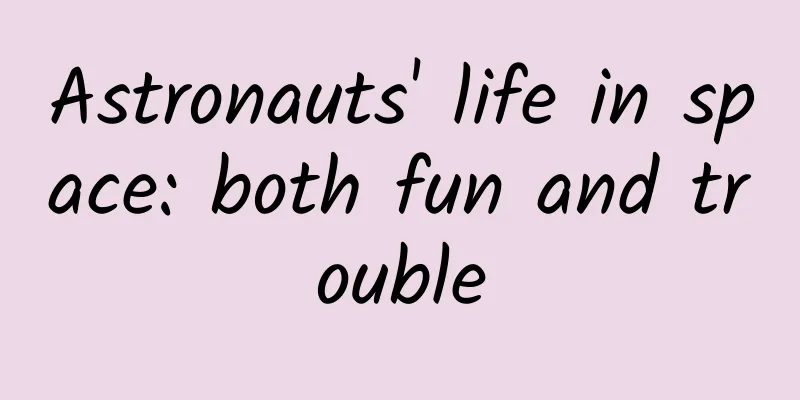Astronauts' life in space: both fun and trouble

|
Compared with the ground, the microgravity environment in space makes life in orbit very different, which has a significant impact on all aspects of astronauts' lives. Many small things that are easy to do on the ground are difficult to do in space, but many things that are unheard of on the ground are easy to do in space. Food and drink with characteristics When talking about life in space, we can't help but talk about eating, drinking, defecating and urinating. Let's first look at how to eat in space. Food in space is not readily available at the market. All food needs to be transported to space in advance by cargo spacecraft or manned spacecraft, and the corresponding types and quantities must be prepared according to the duration of the mission. For space launch missions where "every inch of land is valuable", space meals generally choose foods that are high in energy, less in residue, easy to store and small in size. Beverages will only be carried in instant powder, and astronauts can brew them in orbit. In order to prevent food from flying around during meals, most food is stored in plastic bags and fixed to the dining table with clips, magnets, etc. With the construction of China's space station, my country's space food is becoming more abundant and the space menu is gradually improving. Compared with the few ready-to-eat foods in the first manned mission of Shenzhou V, the Shenzhou XIII manned flight mission carried 127 different space meals, and optimized them according to the personal preferences of the astronauts, such as preparing Northeastern stew for Zhai Zhigang from Qiqihar, Heilongjiang, seafood for Wang Yaping from Yantai, Shandong, and spicy dishes for Ye Guangfu from Chengdu, Sichuan. What's more special is that in this mission, Chinese astronauts celebrated the New Year in space for the first time. The three astronauts ate dumplings with their favorite fillings in space, with three kinds of fillings to choose from: pork and cabbage filling, Spanish mackerel filling, and day lily filling, and spent New Year's Eve with 1.4 billion people in China. In the subsequent Shenzhou XIV manned flight mission, astronauts will spend the Mid-Autumn Festival in space, and mooncakes are indispensable in their luggage. Liu Yang and Chen Dong will also celebrate their birthdays in orbit, and the Astronaut Center specially prepared food blind boxes for them, hoping to bring them surprises. Compared with food, water is a more precious resource for life in space. An adult needs to drink about 2 liters of water every day. For a crew of three astronauts, living in orbit for 6 months requires 1,080 liters of water, equivalent to more than 1 ton. Of course, this does not include water for other purposes. Obviously, such a huge demand for water resources cannot afford to be wasted. The space station has designed a complete water resource recycling system to minimize the amount of water carried. The regeneration life support system of the Chinese space station can collect astronauts' urine, sweat and water vapor in the space station, collect pure distilled water by rotary distillation, and obtain drinkable recycled water at a rate of 2.5 liters per hour and an efficiency of more than 80% after deep purification by the water treatment subsystem. Astronauts on the International Space Station often joke that "yesterday's coffee is today's coffee". After the Shenzhou XII crew returned safely to the ground, they also joked to the Shenzhou XIII crew that was about to go to space: "We have a lot of recycled water up there, and we left it for you. Please taste it." This may sound hard to accept at first, but this is the daily life of astronauts. The recycled water can fully meet the drinking standards after treatment, and astronauts have long been accustomed to it during ground training. Many health problems It is even more troublesome to solve sanitation problems in space. In a weightless state, excrement cannot fall naturally. In order to prevent them from flying around, astronauts need to fix themselves on the toilet seat when they are convenient, and use a vacuum cleaner-like exhaust system to suck away the dirt. The two standing toilets on the International Space Station are located in Zvezda and Tranquility, both of which are designed by Russia. Due to their age and aging equipment, these two toilets have had problems from time to time, and astronauts have had to collect waste in "manual mode" and even use diapers, which is very troublesome. This problem was not solved until NASA sent a new toilet worth $23 million in October 2020. The Chinese space station also has two independent sanitary areas, located in the Tianhe core module and the Wentian laboratory module respectively. The newly designed sanitary areas well ensure the comfort and privacy of astronauts in orbit. Female astronaut on the International Space Station demonstrates how to use the toilet in space It is not pleasant to take a shower in space, and the flying water droplets may pose a threat to various instruments in the cabin, so astronauts can only wipe their bodies with a wet towel. After returning, Shenzhou 13 astronaut Zhai Zhigang said that the most common operations on the ground, such as getting up early to wash their faces and taking a shower after exercise, are the things they miss most in the sky, so he made an appointment for a scrub early before returning to the ground, ready to enjoy the fun of a normal shower. It is worth mentioning that Zhai Zhigang also mentioned a small detail that is very difficult in orbit - cutting toenails in orbit. First, it is very tiring to retract the legs and feet in orbit, "you need to bend them", and second, you need to constantly collect the debris that has been cut to prevent it from flying around. Such small experiences are also of great reference value for future manned flight missions. There are many entertainment options on orbit Astronauts have many ways to relax and have fun in orbit. Just being able to float and fly in a weightless state is enough to be envied. Many people have seen Chinese astronauts running and watching TV series in the space station. During the Spring Festival, astronauts wrote Spring Festival couplets in space with pen, ink, paper and inkstone, and also appeared on the stage of the Spring Festival Gala. On weekends and holidays, astronauts can freely arrange entertainment activities. They can spend their time watching movies, listening to music, reading books and other entertainment activities. Of course, the most unique way to relax in space is to look out the window at the earth and the deep universe. The cupola of the International Space Station is the best viewing spot, and the panoramic skylight composed of seven large glass panels has a perfect view. The sleeping area of Chinese astronauts can be said to be the ceiling of the space bedroom. Each astronaut has his or her own unique private space. Family photos and small toys can be placed on the wall to dispel homesickness. Each sleeping area is also equipped with a porthole, so that you can look out the window at any time to the blue ocean, floating clouds and vast continents of the earth when resting in orbit. Appropriate entertainment activities add a lot of color to life in a closed space station, which is conducive to bringing a relaxed psychological state to astronauts and improving their work efficiency. Astronaut reading a book on the International Space Station With the development of commercial aerospace, the space tourism industry has gradually emerged. Nowadays, some wealthy people have paid a lot of money to board the International Space Station to experience the infinite charm of space life. With the development of aerospace technology, the cost of commercial aerospace is gradually decreasing. I hope that in the foreseeable future, space tourism can be popularized and everyone can have the opportunity to experience this unique space life in person. |
>>: I thought I was gaining weight, but it turned out to be a tumor?
Recommend
Flurry: Mobile gamers spend less time playing but more money
[[147285]] Flurry, a mobile application data anal...
How many Douyin stores can a Blue V open? What are the differences between Blue V and Enterprise Account?
After merchants successfully open their own store...
WeChat can now send large files! HD videos will not be compressed, iOS already supports it
At noon on November 20, the Tencent WeChat team c...
What is it like to be you?
Leviathan Press: When we talk about character, we...
Gehua Cable TV will be the next Wasu Media
Gehua Cable sells a large order of 33 yuan On Marc...
[Creative Cultivation Program] Fish are the evidence that the Tarim Basin actually "drifted" from the equator
Author: Gai Zhikun Shan Xianren Reviewer: Zhao We...
Why do we say that the Earth once had rain for millions of years before the ocean was formed?
The Earth is a planet filled with liquid water, w...
Gaming on smartwatches: Break through or stop
Editor's note: I always think that making gam...
Why are Western countries so concerned about facial recognition technology?
Facial recognition technology is now prevalent in...
The product promotion logic of Internet advertising!
What the advertising business sells is every one ...
Domestic cars can also be so cool. Roewe i6 opens a new chapter of intelligent interconnection
At the 2016 Guangzhou Auto Show, SAIC Roewe relea...
How to avoid pitfalls when investing massive amounts of money in Qianchuan?
Failure to pass the review and lack of traffic ar...
Xiaokele mobile phone review: a thousand-yuan camera magic tool (hardware imaging)
In terms of appearance and system design, the styl...
Does smoking affect your appearance? It’s true!
Author: Xiao Dan, Director of the Department of T...









